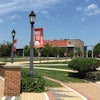Bringing Graduate Education to the Workplace
Paying for books and little else, company employees benefit from Webster University’s Corporate Cohort program.
By Peter Galuszka
Just after work at 5:30 p.m. most Wednesdays, Sheri Graham hops in her car, tosses her textbooks and notepads on the passenger seat, and settles in for a 90-minute drive to St. Louis from Farmington, Mo. There, at her employer’s headquarters, Graham and 64 other employees are enrolled in a 2.5 hour-long graduate business class. She usually arrives home around 11:30 p.m.
Graham, human resources director for Parkland Health Center in Farmington, says the strenuous Wednesdays don’t bother her.
The health center is owned by the medical care firm BJC HealthCare Corp., which is paying most of Graham’s tuition for the course. Next May, Graham will receive an MBA that will significantly enhance her value as a company employee.
“This program is excellent,” she says. “A traditional program would not work for me.”
“Traditional” is one word that does not describe Webster University’s four-year-old Corporate Cohort Program.
The St. Louis-based university partners with businesses, bringing classes directly to the work place.
“The importance of the course is that you deal with the flexibility issue right up front,” says Dr. Benjamin Akande, dean of Webster’s Graduate School of Business and Technology.
Between 250-300 students participate in Webster’s corporate cohort program, which to date partners with companies in Arkansas, Colorado, California, Florida, Missouri and South Carolina.
Webster has been a pioneer in higher education outreach. Years ago, for example, it opened small campuses on military posts throughout the country and overseas to give military personnel the chance to earn college degrees.
Webster’s cohort concept was the product of a collaboration with mass-retail giant Wal-Mart. Headquartered in rural Bentonville, Ark., Wal-Mart had been exploring on-site graduate studies that would be cost-effective yet convenient for employees. Webster operated a campus in nearby Fayetteville, and in 2003 the two began discussing ways to work together.
Akande says he sees a series of “win-win” results from the close collaboration that is the hallmark of the cohort program.
“You take people in large corporations who do not work together and you bring them together in a classroom environment,” he says. “I think from a corporate expense perspective, this enhances communication and the flow of ideas.”
Because the courses are taught on-site in the evenings, it’s easy for company employees to attend. The program typically takes little more than two years to complete and involves about 12 courses five times a year. The majority of the courses cover MBA requirements, but electives can be tailored to meet the host company’s needs. At BJC, for instance, the electives can be drawn from Webster’s health care administration courses.
“They’ve been unbelievably flexible,” says JoAnn M. Shaw, BJC’s vice president and chief learning officer. “We needed to focus the finance course more on health care finance and they did it
right away.”
One big plus for participating companies is the cost. Shaw says the courses cost about $15,000 per employee, most of which is covered by the company. She says she and BJC’s president and CEO, Steven H. Lipstein, were both recruited from University of Chicago Hospitals, which had placed a premium on continuing education.
“The CEO recognized the retention value of letting employees have the tools to be successful. Every employee had to participate in some courses,” she says.
After arriving in St. Louis, Shaw and Lipstein planned to introduce a similar program at BJC. But first, they had to find a local MBA program to partner with. St. Louis is home to several higher education institutions, including Washington University, with which BJC has an active partnership. “But they were too costly,” says Shaw.
Indeed, resigning from a job or taking a leave of absence can be a major financial burden on a student. The average cost of an MBA is about $30,000 per year, for what is typically a two-year program. But costs at top-tier schools can be much higher. Tuition at Harvard Business School, for example, is $41,000 a year. But total costs, including room and board, push that total to $73,000 a year.
Webster’s cohort program, however, is financially negligible for students, who pay for their books but little else. Because they have day jobs and are already established, there is no room and board to cover, and the company pays the bulk of the tuition.
Shaw says that BJC, which has 27,000 employees and operates
13 hospitals and long-term care facilities, pays about $351,000 for 65 students for five terms.
But while there are many benefits of the in-house MBA approach, some experts question whether it’s really the best option. One of the advantages of mainstream graduate business schools is that students interact and form career-long connections with a diverse range of other students.
“I can’t disagree with that,” says Shaw of the benefits of traditional MBA programs. “But given our size, we are almost like a small city, and we come from diverse backgrounds, from academic to rural.”
She also says there are inherent benefits in learning alongside their peers in the work place.
Lisa Locker, a BJC employee who works at Missouri Baptist Hospital-Sullivan, agrees.
“We are with colleagues in our own system and we do interact with other people and issues. Meanwhile, I’ve really enjoyed our teachers and they apply examples to real-life experiences,” says Locker. Her hospital is located about 65 miles from St. Louis, so, like Graham, she faces a long weekly commute to class.
Akande says that besides serving practical needs, the cohort program pushes the educational envelope.
“The future of education will be finding the way to meet the needs for the iPod generation,” he says. “These people are very unique, and their loyalty is not to the institution but to content. Content is their oxygen. Raised by computers, this generation is very fluent in technology and likes to be challenged.”
Consequently, institutions of higher education must find new ways to provide content that suits everyday realities.
“It will force us to change our delivery system,” says Akande. “The Cohorts graduate business program may be an example of that.”
There are currently 0 comments on this story.
Click here to post a comment.
© Copyright 2005 by DiverseEducation.com















